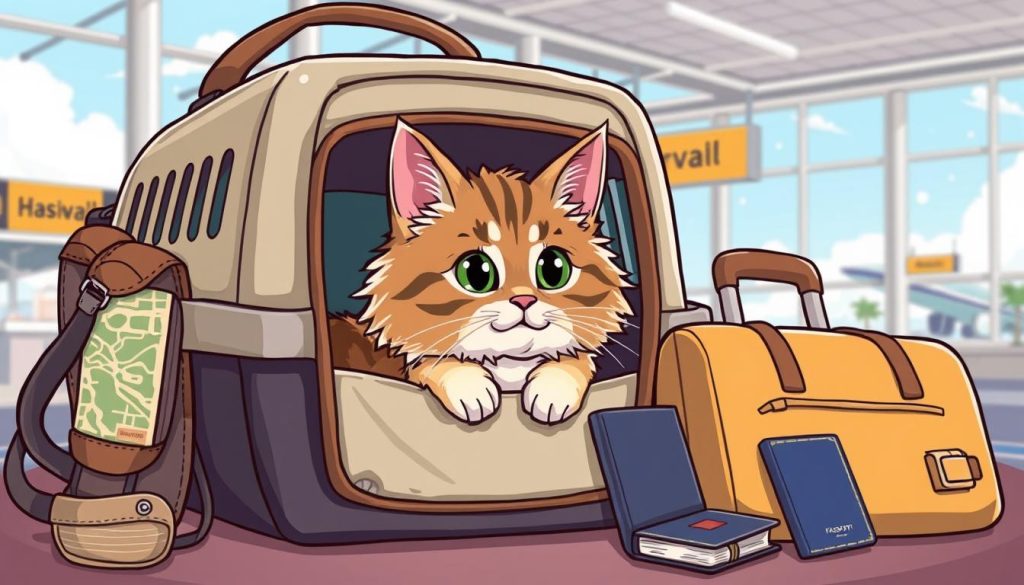Traveling with your cat can be rewarding but needs careful planning. This guide will give you tips to make trips safe and fun for you and your cat. You’ll learn how to pick the best carrier and help your cat feel less anxious during travel.
Whether it’s a road trip, a flight, or a stay at a pet-friendly hotel, knowing what your cat likes is key. This guide will help you prepare for amazing adventures with your cat.
Key Takeaways:
- Explore the various types of cat carriers available, ensuring the right fit for your cat’s size and comfort1
- Understand the importance of carrier placement and securing your cat during car travel1
- Learn how to address potential anxiety and stress in cats during travel, including the use of pheromone products23
- Discover the key essentials to pack, such as familiar litter, toys, and cleaning supplies, to make your cat feel at home during the journey12
- Familiarize yourself with airline policies, vaccination requirements, and identification needs for your cat when traveling by air13
Preparation for Traveling with Your Cat
Get the Right Cat Carrier
Choosing the right cat carriers is key for your cat’s safety and comfort on trips. Look for carriers with front and top openings for easy access. They should be big enough for your cat to move around and feel safe. Soft-sided carriers are good for flying, while hard-sided ones are better for driving.
Let your cat get used to the carrier at home before you go. Also, make sure you have all the cat travel documents you need, like vaccination proof, for places you visit or fly to4.
For cat travel essentials, the right carrier is just the start. Cats can wait a long time to use the bathroom, so plan for breaks during your trip4. CBD oil and pheromone spray can help calm your cat during travel4. Easy Traveler by Jackson Galaxy can also ease their fear and stress4.
Get your cat used to a backpack carrier before big trips4. Even if they’re okay with their carrier and favorite things, they might still feel uneasy on the road4. Make sure they’re ready for the trip by introducing them to the carrier and taking short car rides early on.
Air travel isn’t recommended for pets, especially cats, because it can be overwhelming with all the noise and changes in temperature5. Cats with short noses are at higher risk because of their narrow noses5. If you must fly with your cat, check the airline’s rules and fees carefully, as they can change a lot5.
For train travel, Amtrak charges $26 each way for pets under 7 hours5. Only one pet can go with each passenger in coach, and pets and carriers must meet size limits5. Many trains let small pets ride if they’re on a leash, in a muzzle, or in a carrier5. Some train stations might ask service animals to wear special vests or tags5.
By getting your cat ready for the trip and picking the right cat carriers and essentials, you can make sure they’re comfortable and stress-free.
Acclimating Your Cat to Travel
Getting your cat ready for travel is key to a stress-free trip6. Not every cat loves to travel, but some can get used to it6. To make your cat feel safe and calm, start by introducing them to the carrier early. Also, get them used to short car rides.
Supplies and Essentials
Don’t forget to pack your cat’s favorite toys, blankets, and treats for the trip6. You might also want a small litter pan, food and water bowls, and a Feliway spray to calm them down6. Make sure your cat has a microchip and a safe H-harness for their safety6.
If your cat gets really anxious when traveling, talk to your vet about natural options or cat sedatives for travel7. Cats under stress can make vet visits tough, so it’s important to keep them calm during trips and at the vet’s office7.
Start getting your cat used to the carrier slowly7. Move from just showing them the carrier to letting them get comfortable with it. Then, close the door a little, then more, and finally, take short drives together7. This should take about a week for each step and should be done often6.
With careful preparation and acclimation, you can lessen your cat’s travel anxiety8. This makes the trip better for both you and your cat8. Training your cat to feel safe in the car can even make them enjoy traveling8.

“Early detection and intervention are important for successful treatment of chronic diseases in cats, highlighting the significance of regular veterinary check-ups.”7
how to travel with a cat
Traveling with your cat can be rewarding but needs careful planning. You must think about your cat’s comfort and safety. There are key things to remember when taking your cat on the road or in the air9.
For road trips, keep your cat’s carrier safe in the car. Give them small amounts of food and water often. Cats can wait a long time to go to the bathroom, but they should go about four times a day9. Make sure to stop often so your cat can stretch and use the litter box. It’s bad for cats to hold their pee too long9.
When flying with your cat, learn about your airline’s pet travel rules. You’ll need to take your cat out of the carrier at security checks. Keep your cat safe and comfortable. Don’t use sedatives for travel; instead, try flower essences, CBD oil, or pheromone spray to help with anxiety9.
Use a strong and comfy carrier for your cat, no matter the travel method9. Plan ahead and think about your cat’s needs for a good travel experience with your feline friend.
To learn more about how to travel with a cat, check out our full guide on the topic.

Preparing for Cat Travel
Get your cat ready for travel before you go. There are three main cat personalities, and some are better for traveling10. Tuxedo cats are lively, social, and smart, often like dogs in personality10. Training your cat for travel takes time and patience, starting with harness training at home10.
- Leash training works at any age, even for adult cats10.
- Cats enjoy exploring and slow down travel, making it more interesting10.
- Give your cat a safe spot like a carrier or backpack for when they feel scared10.
- Cats can sense their owner’s mood, so staying calm helps them during travel10.
- Follow pet rules, keep cats on leashes, and clean up after them to respect others and the environment10.
Preparing your cat well makes travel better for you and your cat10.
“Traveling with your cat can be a rewarding experience, but it requires careful planning and consideration for your feline companion’s comfort and safety.”
Essentials for Cat Travel
For cat travel, you need the right supplies. Use a travel litter box, and some cats can even use a toilet10. It’s okay to leave cats at home if some places aren’t good for them10.
Being ready and caring for your cat’s needs makes travel smooth and fun for you both910.
Conclusion
Traveling with your cat can be rewarding and fun, but it needs careful planning. Choose the right carrier and help your cat get used to traveling. This way, you and your cat will have a safe and fun trip11.
Some cats might not like long trips because of stress, their face shape, or size. But, with the right steps, you can make it work11. Don’t give your pet medicine to calm them down, as it can be bad for their health11. Instead, make the trip good by taking breaks and being patient, kind, and loving12.
With the right attitude and safety steps, you and your cat can see new places and make great memories. It doesn’t matter if you’re flying, taking the train, or driving. Always think of your cat’s comfort, safety, and happiness. This way, you’ll both have a great trip13.
FAQ
What type of cat carrier is best for traveling?
The best cat carrier has front and top openings. It should be big enough for your cat to stand up, turn around, and feel safe. Soft-sided carriers are good for flying because they’re easy to carry. Hard-sided carriers work well for car rides.
How can I help my cat adjust to the idea of travel?
Start by letting your cat get used to the carrier at home. Take them on short car rides or keep them in the carrier for a bit. This makes travel less scary. Bring their favorite toys, blankets, and treats to make them feel at ease.
What should I consider when traveling with my cat by car?
When driving, keep the carrier safe in the car. Give your cat a little food and water. Stop often so they can stretch and use the litter box.
What do I need to know about traveling with my cat by air?
Learn about your airline’s pet travel rules. You’ll need to take your cat out of the carrier at security checks.
How can I help my cat if they experience travel anxiety?
Talk to your vet about ways to calm your cat during travel. Getting them used to the carrier and creating a calm space can make a big difference. This can help make their trip better.

